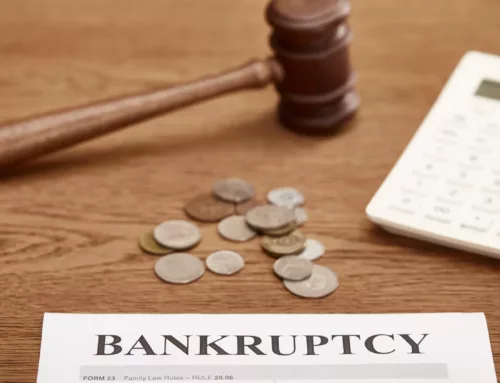Learn Ways to Stop Tax Refund Garnishment in Bankruptcy
Bankruptcy gives people the power to open the door to a better, debt-free future by providing a protective barrier and enabling them to regain control of their finances. The legal option of bankruptcy, which aims to give people and organizations a new financial start, can significantly lessen the pressures of astronomical debt. One of its many advantages is ways to stop tax refund garnishment in bankruptcy.
Bankruptcy offers people a potent way to stop tax refund garnishment and achieve financial stability and peace of mind. Garnishments can be stopped immediately by filing for bankruptcy, allowing people to keep their well-earned tax refunds. But mastering the complexities of bankruptcy law can be difficult and confusing. Hammerschmidt Stickradt & Associates have reliable and knowledgeable bankruptcy lawyers who can help you identify how to stop tax refund garnishment through bankruptcy.
Here, we will discuss 3 common ways to stop tax refund garnishment in bankruptcy:
- File for bankruptcy
- Negotiate a Compromise Offer
- Create a payment schedule
In order to successfully stop tax refund garnishment and pave the path for a better financial future, a bankruptcy attorney’s experience and advocacy are quite crucial. At Hammerschmidt Stickradt & Associates, we help people in their time of financial need with passionate, genuine care. Contact us today to schedule a free consultation.
What are the Ways to Stop Tax Refund Garnishment in Bankruptcy?
File for Bankruptcy
Tax debt is similar to other types of debt. You may choose to file for bankruptcy if you are unable to pay your debts. With bankruptcy, you can start over with a comparatively clean financial slate and reorganize or discharge your current debts.
Remember that bankruptcy will show up on your credit reports and make borrowing money in the future very difficult. Still, bankruptcy is a good final alternative for those who are in precarious financial situations.
You need to get in touch with the IRS and let the agency know if you are filing for bankruptcy or have already done so. People who want to stop their tax refunds from being garnished might do so by filing for bankruptcy, particularly under Chapter 7 or Chapter 13. They may also be able to remove or restructure their tax debts.
Chapter 7
Known also as liquidation bankruptcy, it may be able to erase some tax debts based on the debtor’s age and other particular requirements.
Chapter 13
This chapter gives people the option to make a repayment plan that lasts three to five years, giving them a chance to make up for missing tax payments and possibly lower the overall amount owed.
Both choices give people the ability to end the garnishment of their tax refunds and recover control over their money while they seek to build a more secure future. To fully grasp the exact ramifications and requirements of declaring bankruptcy concerning tax refund garnishment, it is essential to speak with a knowledgeable Michigan bankruptcy attorney like Hammerschmidt Stickradt & Associates, who can help you with your concerns.
Negotiate an Offer in Compromise
An offer in compromise is a strategy for engaging with the IRS to proactively settle your tax liability, much like creating a payment plan. Negotiating an Offer in Compromise (OIC) with the tax authorities can be a successful strategy for stopping tax refund garnishment. An agreement between the taxpayer and the Internal Revenue Service (IRS) to settle the tax liability for less than the entire amount owed is known as an offer in compromise.
People who successfully obtain an OIC may be able to lessen their overall tax obligation in addition to stopping the garnishment of their tax refunds. This procedure entails a careful analysis of the taxpayer’s financial condition, including their sources of income, their expenses, and their assets. To successfully manage this difficult process, it is advised to speak with a trusted lawyer or enrolled agent who specializes in tax negotiations.
A skilled bankruptcy lawyer will do a complete evaluation of your financial status, taking into account your earnings, outgoings, assets, and liabilities. They will collaborate closely with you to compile the necessary financial data and make a strong case for the IRS. Based on your particular circumstances, they can assist in determining whether an OIC is the right course of action and act as an advocate for your interests.
Set a Payment Plan
Usually, the IRS is open to working with taxpayers who owe back taxes. If your inability to pay your tax debt in full is the cause, get in touch with the IRS to arrange a payment plan. You can arrange a short- or long-term payment plan for a nominal cost, depending on how much you owe. With the help of these plans, you can convert a hefty one-time purchase into more manageable monthly payments over a period of up to six years.
Basic Steps to Set up a Payment Plan
Here are some basic steps to set up a payment plan in order to stop tax refund garnishment:
- Evaluation of Your Financial Situation
Determine how much you can afford to pay toward your tax burden each month by taking a look at your financial situation. Take into account your income, spending, and any other debts you may have. This will enable you to suggest a payment schedule that is both reasonable and economical for you.
- Proposal for a Payment Plan
Describe your desired payment plan in a formal proposal. Include information on the term of the payment plan, the monthly payment amount, and any supporting records that illustrate your financial situation. Be willing to bargain and be flexible in order to come up with a strategy that you and the tax authority can both accept.
- Agreement and Implementation
You will receive an agreement explaining the terms and conditions of the payment plan once your request has been granted. Make sure you comprehend the payment schedule, interest rates, and any other pertinent conditions by carefully reading the agreement. The agreement must be signed and delivered to the tax authority as directed. After then, you can start paying your tax liability according to the terms of the agreement.
By establishing a payment plan, a bankruptcy attorney can help stop the garnishment of tax refunds. They can navigate the complicated legal framework and comprehend the nuances of the bankruptcy process to safeguard your rights and interests.
Call our Michigan Bankruptcy Attorney to Help Stop Tax Refund garnishment in Bankruptcy
To stop the garnishment of tax refunds, it is essential to seek the advice of a knowledgeable bankruptcy lawyer. These attorneys have the knowledge and experience necessary to understand the intricate bankruptcy rules and to strongly defend the interests of their clients.
Michigan bankruptcy lawyers, like Hammerschmidt Stickradt & Associates, are skilled and knowledgeable to help you with ways to stop tax refund garnishment in bankruptcy. The garnishment may be completely stopped or different ways to deal with the underlying debt may be found. Michigan bankruptcy lawyers can also negotiate on behalf of their clients with creditors and the bankruptcy trustee to get the best result possible.
Hammerschmidt Stickradt & Associates can manage complex documentation, negotiate with creditors and the bankruptcy trustee, and work toward the best result. Reach out to our Michigan bankruptcy lawyer and schedule a free consultation to learn more about your legal options!



